

FOOD & WINE

Discovering Friuli Venezia Giulia is also about experiencing the way of life of the people who live there, including the history and traditions that have shaped the character and customs of this territory. And what could be more captivating and exciting than diving into the food and wine pleasures of a Region that embraces so many different landscapes, climates and cultures? In order to give you the best possible taste of what our land has to offer, we have set out in these pages a route that will take you on a journey through the wines, recipes and products that we hope you will enjoy on your next trip, together with the sincere and passionate hospitality of the producers and restaurant owners. Many mouthwatering destinations, from the mountains to the hills, from the Friulian plain to the sea. Many appointments that you just can't miss, from the taverns of Udine to the buffets served in Trieste, from the sweetness of Prosciutto di San Daniele to the fragrances of wines that are celebrated throughout the world. Have a safe journey and "buon appetito".
THE STAGES
Page 6

THE VINEYARDS OF FRIULI VENEZIA GIULIA
A journey to discover a truly unique territory and winemaking tradition in the DOC wine districts and their visionary producers
Page 16

JEWELS TO BE DISCOVERED IN THE ALPS
The spectacle of the Alps and the flavours of the extraordinary ingredients from the mountains we are blessed with
Page 40

AT THE TABLE ALONG THE TAGLIAMENTO RIVER
The King of Alpine rivers and the recipes to be enjoyed in the territory it flows through
Page 46

THE ELEGANCE OF PDO PROSCIUTTO DI SAN
DANIELE
A visit to San Daniele del Friuli to discover the Prosciutto that has conquered the world
Page 56

FRICO, SIMPLE AND DELICIOUS
Enjoy the most iconic dish of Friuli in all its many variations with a good glass of red wine
66

THE TRATTORIE AND OSTERIE IN UDINE AND ITS SURROUNDING TERRITORY
The beauty of the city of Tiepolo and the unparalleled hospitality of its typical taverns
84

GORIZIA, A ROSE AMONG THE HILLS
A highly prized red radicchio is the crown jewel of a city bursting with charm and tradition
Page 96 Page 90
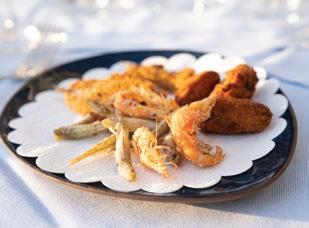
FLAVOURS OF THE ADRIATIC SEA
Along the coast, from Lignano Sabbiadoro to Muggia, following the trail of good food from the sea

THE BEAUTY AND GREAT TASTE OF THE LAGOON
Enchanting and exciting natural environments that have no equal and their authentic flavours
Page 100
Page 106

THE CAFÉS OF TRIESTE, SO MUCH HISTORY
In the capital of coffee, a meeting point of cultures, including gastronomy, and the memory of great literary figures
Page 110



THE SPECIALITIES OF THE KARST REGION AND TRIESTE
A great city that invites you to pleasant culinary stops, from the coast to the hinterland
VISITING OSMIZE ON THE PLATEAU
Above Trieste, the Karst, its great products and very special hospitality

THE WINES OF FRIULI VENEZIA GIULIA, PERFECT AND UNREPEATABLE HARMONY


MALVASIA ISTRIANA
From a grape variety that traces back into history, a perfect wine for seafood dishes
VITOVSKA
A native grape variety featuring a fruity aroma, the flagship of the Karst region of Trieste
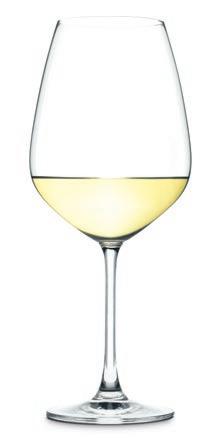

SAUVIGNON
A transplanted French grape variety that in our territory is enhanced with freshness, flavour and elegance.


FRIULANO
The former Tocai makes its powerful voice heard in all the DOC wine districts of the Region
PINOT BIANCO
Refinement, softness and delicacy are all expressed in a unique wine

CHARDONNAY
The most popular white wine in the world delivers excellent results in our Region
RIBOLLA GIALLA
A native grape variety that knows how to be fresh and clean, whether sparkling, dry or macerated on the skins


PROSECCO
An international success, this sparkling wine takes its name from a village in the Karst.

PINOT GRIGIO
A wine with colours ranging from white to copper, obtained from the most widely planted grape in the Region

Always ready to produce sweetness and body that holds up to any food pairing
THE EXCELLENCE Where worldfamous white wines are born

In the early 1970s, a revolution in the production style of white wines began in the Region, combining power and elegance with crisp aromas. Within a few years, these parameters of quality had been surpassed, rejected and then redefined and written once again. It did not take long for some producers to replant and improve indigenous grape varieties, anticipating a trend that was destined to become popular.

PICOLIT
A wine of incomparable elegance and delicacy, for refined and demanding palates
RAMANDOLO

CABERNET SAUVIGNON
A grape variety from France that has found a perfect terroir in Friuli Venezia Giulia


SCHIOPPETTINO
A fine and elegant red wine from Prepotto, in the Colli Orientali del Friuli wine district
MERLOT
Pure or in prestigious blends, it is the most widespread red wine in the DOC wine districts of the Region

CABERNET FRANC
Strong tannic body and herbal sapidity for a classic wine of this territory

PINOT NOIR
The most elegant of the international reds also performs particularly well in our territory

TERRANO
PIGNOLO
Rich in tones and nuances, this is the great evolution of reds from the Colli Orientali del Friuli wine district
THE EXPERIENCE
Red from the Karst with a ruby-purple colour, it offers hints of earth and blueberries


Discovering a tradition full of emotion and passion

An indigenous red wine, which is straightforward, inviting and well structured
The history of wine in Friuli Venezia Giulia was already on the road to innovation in the last years of the 19th century, thanks to the decisions of the 4th Austrian Oenological Congress, held in 1891 in Gorizia, then part of the Hapsburg Empire. The Congress changed the viticultural history of our Region thanks to two important steps. The first was to combat phylloxera by grafting European varieties onto American vine stock, which is immune to the aphid. The second was the decision to introduce vines mainly from France to the territory. Over the decades, these varietals have been able to express their full potential by exploiting the qualities of the terroirs of Friuli Venezia Giulia.
REFOSCO DAL PEDUNCOLO ROSSO
THE DOC WINE DISTRICTS OF FRIULI VENEZIA GIULIA
Respect for the territory as the shared common denominator
Alongside the DOC Friuli, or Friuli Venezia Giulia, and DOC Prosecco wine districts, which cover all the winegrowing areas of the Region, wine production is also organised in the DOC Friuli Grave appellation, which crosses the plains of Udine and Pordenone, as well as the wine districts of DOC Friuli Latisana, DOC Friuli Annia, DOC Friuli Aquileia, DOC Friuli Isonzo, DOC Carso and the two hillside DOC zones: DOC Collio or Collio Goriziano, and DOC

Friuli Colli Orientali. In addition to these denominations, there are also three DOCG wine districts: Ramandolo, Colli Orientali del Friuli Picolit and Rosazzo, as well as the DOCG Lison, in the province of Pordenone.
DOC FRIULI GRAVE
DOC
Pordenone
DOC FRIULI
DOC FRIULI
DOC FRIULI COLLI ORIENTALI
DOCG
DOCG ROSAZZO
DOC COLLIO
DOC FRIULI
ANNIA
AQUILEIA
ISONZO
DOCG RAMANDOLO
COLLI ORIENTALI DEL FRIULI PICOLIT
DOC CARSO

BETWEEN THE ALPS AND THE ADRIATIC SEA
A diverse territory where indigenous, traditional and international grape varieties are cultivated

A diverse territory where indigenous, traditional and international grape varieties are cultivated. The excellence of Friulian wines is the result of an extraordinary combination of environmental and climatic elements that give this territory perfect conditions for growing vines and producing exceptional high-quality wines. In this small region, the shelter of the Alpine chain and the breezes of the Adriatic Sea create ideal temperature variations for the development of aromas in the wine. Soils with heterogeneous characteristics, consisting of marls and sandstones rich in minerals from Karst rocks, or even soils of alluvial origin, are at the heart of certain aromas and acidities and represent the foundation for grapes with unique and distinctive characteristics.
A combination of unique qualities that a refined oenological culture, respect for the land and the skills of the producers have transformed into wines that are appreciated all over the world. The perfect environmental balance for the cultivation of vines that typifies the territory and climate of Friuli Venezia Giulia is complemented by the wisdom and foresight that have led these wines to win over the most demanding consumers and experts everywhere. It is even more exciting to discover them here, where they have come to life.



THE CARNIC ALPS AND THE FRIULIAN DOLOMITES, NATURE TO RESPECT AND SAVOUR

MONTAGNE FRIULANE
A cuisine based on tradition and exceptional ingredients

Small bundles of pasta that encapsulate the flavours of the Friulian mountains, Cjarsons are one of the most emblematic dishes of Friuli Venezia Giulia. They are prepared at home according to recipes that are often secret, with ingredients and quantities that vary according to where they are made. They look like ravioli made from a dough of flour, water and oil. Once cooked in boiling salted water, Cjarsons are served with Morchia, a typical condiment made from corn flour toasted in melted butter. The dish is completed with a generous grating of hard-smoked ricotta cheese.



Typical of Carnia, Cjarsons are a first course which combines a soft wheat dough with a filling characterised by the contrast between sweet and salty. The ingredients include raisins, cocoa, cinnamon, spinach, ricotta cheese, jam, grappa, parsley, dry biscuits, eggs and milk.
Side picture
Grated smoked Carnic ricotta cheese is an absolute must on Cjarsons
Top picture
Two Slow Food Presidia: Red Onion from Cavasso Nuovo on the left and Resia Garlic on the right

Thousands of species of wild herbs grow in the meadows of the plains, hills and mountains that shape the landscape of Friuli Venezia Giulia, a resource that tradition and necessity have taught us to use in simple and refined and refined first courses, main courses and side dishes.
Perhaps the most popular wild herb in the local cuisine of the territory is silene (Sclopit in the Friulian language), which is used in omelettes, risotto and other first courses. Wild hop (Urticiòn in Friulian), which grows near watercourses and can be recognised by its characteristic green shoots with reddish tones, is also highly prized and is the basic ingredient of many types of risotto and omelette. Dandelions are easy to find almost everywhere and are excellent when cooked in a pan or used to enrich the flavour of risotto, omelettes and savoury pies. Thanks to its beneficial properties, nettle is harvested all over Friuli Venezia Giulia. It is at the heart of delicious vegetarian recipes and an exquisite risotto
known as "Risotto alle ortiche", a delicate and slightly bitter first course. Another wild herb that grows in the Region is wild garlic, rich in vitamins and minerals. In the kitchen, its leaves are used to prepare a pesto sauce with an original flavour, as well as soups and omelettes.
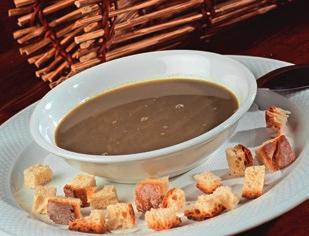
Wild herbs add incomparable aromas and flavours to the soups and broths typical of each area of the Region.
The history of Toç in braide is rooted in the land and its recipe has been handed
down for generations.

The famous Toç in braide (which in the Friulan language means ''farmhouse sauce'') is soft, warm polenta mixed with a creamy blend of quality ingredients. The history of Toç in braide is rooted in the land and its recipe, handed down for generations, consists of

polenta mixed with a particular combination of local ingredients. Originally, leftover cheese available in the house was used to create a fondue. This was then added to the sauce together with corn flour toasted in a frying pan with butter.
The Carnic Alps, the Friulian Dolomites, the territory of Tarvisio, the Canale Valley and the Natisone Valleys are part of the heritage of
Friuli Venezia Giulia thanks also to the beauty of the landscape that the love of the people who live in these mountains has preserved
FORMÀDI SALÂT
Made from raw cow milk, it is left for 2 to 4 months in wooden vats with a brine of water, cream and milk.
MONTASIO DOP
Versatile and highly aromatic, the production techniques of Montasio cheese are said to have been refined around 1200, thanks to the Benedictine Monks.

GOAT CHEESE
From the soft and fresh Caprino, to the fat and semi-hard Caciotta, to the aged goat cheese varieties that are both crumbly and strong in flavour.



CUÇ DI MONT
Typical of the mountain areas throughout the Region, it is made with the summer milk of cows grazing in the pastures. It features a variety of flavours and a fragrance of mountain grass. It is intense on the palate with a slightly bitter, very pleasant aftertaste. Cuç di mont is a Slow Food Presidium.
intact. The cheese varieties made from the milk of the cows, goats and sheep that graze here, thanks to the fodder and the scents and aromas of the local plants, offer delicious flavours that delight our palates. Embark on a journey and be ready for a unique sensory experience.
STELUTIS

FORMÀDI FRANT
Delicate and with a slightly acidic vein, this cheese has the flavour that only cow's milk from the mountains can provide.
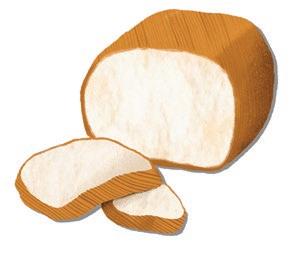
Made from crushed and smoked cheese from alpine pastures of different ages, mixed with salt, pepper and cream.

ALTO BUT E ALTO BUT VECIO
RICOTTA
It can be prepared fresh, smoked or crumbled. Essential for pumpkin gnocchi and Cjarsons cooked to perfection.
A cheese steeped in the scents of the herbs and hay from the valleys at high altitudes. It presents a full and pleasant taste on the palate.


The specialities made from raw cow milk and processed on farms at an altitude of 1,500 metres are an absolute must.
The quintessential expression of these mountains.

PDO Montasio is a cooked, semi-hard cheese made exclusively from cow's milk.
The production techniques for PDO Montasio cheese have been handed down and perfected since the 13th century, thanks to the efforts of the Benedictine

monks who lived at the time in the Abbey of Moggio Udinese, on the northern slopes of Mount Montasio. The techniques developed by the monks became widespread in the valleys throughout Carnia and, over the last two and a half centuries, in the entire Region of Friuli Venezia Giulia

PDO Montasio cheese is identified by the mark of origin on the heel of the cheese, which consists of the word "Montasio" stamped on the wheel at an angle and repeated over the entire surface.
PDO Montasio cheese has its origins in and takes its name from the Montasio mountain massif in the Julian Alps of Friuli Venezia Giulia. Its production, which began around the year
1200 in the valleys of the Julian and Carnic Alps, spread over time to the entire plain, preserving the strict rules of its ancient tradition.
PDO Montasio is a large cheese made from cow's milk, with a cooked, semi-hard paste and a

soft, delicate and well-balanced flavour, without being too strong. It is particularly digestible because it is naturally lactose-free and can be enjoyed by everyone. This extraordinary product has four distinct varieties, depending on how long it has been aged: fresh ( from 60 to 120 days), with a soft and delicate taste; medium (aged from 5 to 10 months), with

a full and decisive flavour; mature (more than 10 months) and pleasantly savoury; extra-mature (more than 18 months) and therefore also suitable for grating. Fresh PDO Montasio has a white, compact paste, homogeneous eyes and a smooth rind. Over time, the paste of medium-aged PDO Montasio becomes grainier and crumblier, while the rind becomes drier and darker, thus becoming aged PDO Montasio.

Malga Montasio / Udine

In Sauris, wild herb soups, first courses seasoned with speck, cheeses from the alpine pastures, smoked ricotta and pastries made with wild berries

Smoked Prosciutto di Sauris is the speciality of a charming village situated 1,200 metres above sea level and accessible by only one road. The preparation

and smoking of pork legs has been handed down from one generation to the next since the 8th century. The smoking process is followed by a long curing period in large rooms where the cool air from the mountains is regularly allowed to pass through. Also typical of Carnia is Radìc di mont or Lidrìc di mont, a very tender wild radicchio that the "malgari" (shepherds) pick in spring and then preserve in oil. Radìc Di Mont is a Slow Food Presidium and is an excellent accompaniment to meats, cured meats and game.
In addition to the lightly smoked Prosciutto, the speck is also one of the specialities produced in
Radìc di Mont
Top picture
Sauris.
A Slow Food Presidium, Varhackara is a special mountain pesto from Friuli Venezia Giulia, whose traditional recipe has been preserved in Timau, a village in the Carnic Alps near the Austrian border. It is excellent on rye bread.

Varhackara is a mountain speciality whose traditional preparation has been preserved in Timau, a village in the Carnic Alps near the Austrian border. It is a pesto cream created to enhance lard which is mixed with diced salami, smoked
Speck, Guanciale, Pancetta and Ossocollo, as well as aromatic herbs. Its aroma is something you will never forget. It is soft and smooth like cream and can be eaten spread on slices of rye bread or warm white bread croutons.

Varhackara is a pesto from the Friulian mountains which is still made today in the town of Timau.
The town of Tramonti, in the province of Pordenone, produces a very unique type of salami called Pitina PGI.

Pitina PGI is a flattened meatball made from the lean meat of sheep and goats. It was created in the mid-19th century to preserve the meat of animals that were no longer productive. The process involves the addition of salt and herbs, a 48-hour smoking process using various aromatic woods and a subsequent curing period of at least 30 days. It is not a sausage, because the Pitina PGI is not wrapped in a casing but sprinkled with corn flour. When sliced, it has a deep red colour, a fine texture, a strong flavour and a slightly smoky aroma.
Pitina PGI is a Slow Food Presidium like the Pan di Sorc,
a sweet and spicy bread, rich with Austrian influences, which is made with rye flour, wheat and Cinquantino corn and filled with figs and raisins.

Pan di sorc

Legends GIANNI COSETTI
Probably the greatest chef that Friuli Venezia Giulia has ever had.
By reviving the traditions of the housewives of Carnia, introducing ingredients that were not considered at the time and by using empirical methods, Cosetti was an extraordinary innovator among the

chefs of his time. His management of the "Roma" restaurant in Tolmezzo consecrated him definitively, before he decided, in the mid-1980s, to devote himself to a restaurant with just a few tables. The gas cooker was replaced by a woodburning stove and international dishes disappeared from the menu. His cuisine is based on old recipes that he reinvents in his own unique style: a choice that made his menus ahead of their time. At the time, Tolmezzo was the only place where it was possible to taste dishes that were strictly seasonal and based on raw materials from the family garden or from local farmers.
A corner of the "Roma". The New York Times has written about Cosetti and chefs such as Ducasse, Bocuse and Vergè have celebrated him.
With its irresistible combination of ingredients, tiramisù is one of the most popular and widely prepared desserts in the world. Several cities and confectioners have claimed paternity of the recipe, but its origin has finally been recognised in Friuli Venezia Giulia

With the inclusion of this cake in the list of traditional food products in 2017, the Italian Ministry of Agriculture has definitively identified Friuli Venezia Giulia and Veneto as the Regions of origin of this dessert. In particular, this cake was invented in the kitchen of the "Roma" hotel and restaurant in Tolmezzo in the 1950s. A version from the Isonzo area is also known: the Pieris tiramisù. Simple to make, the tiramisù alternates rows of ladyfingers soaked in coffee with layers of mascarpone cream, all decorated with a veil of cocoa.
Tiramisù

With its rounded shape and soft curves, reminiscent of the hills of the Natisone Valleys where it originates, the Gubana is a multiethnic cake that is prepared, modified and reworked according

to different recipes in the towns of the eastern part of Friuli Venezia Giulia. Originally invented for Easter and Christmas, but now eaten all year round, the cake has many versions that have been created over time as a result of cultural and ethnic influences: the Gubana of Gorizia, the Gubana of Cividale or of the Natisone Valleys, the Presnitz, the Italian, Slovenian and Austrian Putizza. There are many variations, but they all share the same preparation: a filling of dried fruit, honey, candied fruit, raisins and other ingredients, contained in a pastry case that can have two types of dough: a leavened dough with eggs and
The landscape of the Natisone Valleys near the Slovenian border.
butter, for the Gubana of the Natisone Valleys, and puff pastry, for the typical Gubana of the area of Gorizia.
Tradition dictates that the sweet be served, or rather doused, with a Slovenian plum-based liqueur, Slivovitz, which in Friuli is often replaced by a very good grappa.

Strucchi

The Strucchi are small dumplings made with the same filling as the Gubana and they can be either fried or boiled
Cividale del Friuli / Udine

Fiume

ALONG THE TAGLIAMENTO RIVER, CARESSED BY ALPINE BREEZES

Part of the tradition of Friuli Venezia Giulia, the salmon trout, cold smoked with herbs, wood and berries, has won many admirers even outside the Region.
Biscotto
Pordenone
is made with durum wheat flour, corn
flour and almonds
Biscotto Pordenone was born in the early 1940s from a recipe conceived to present a cake that could be identified with the products and customs of the territory. Its ingredients recall the raw materials that once formed the backbone of the local diet, such as corn flour and dried fruit. The main components of this pastry product are durum wheat
flour and corn flour, reminiscent of the old mills of the town, together with sugar, almonds, margarine, egg yolks, natural flavours and yeast.


The Biscotto Pordenone. Below: a view of Sacile, in the province of Pordenone.
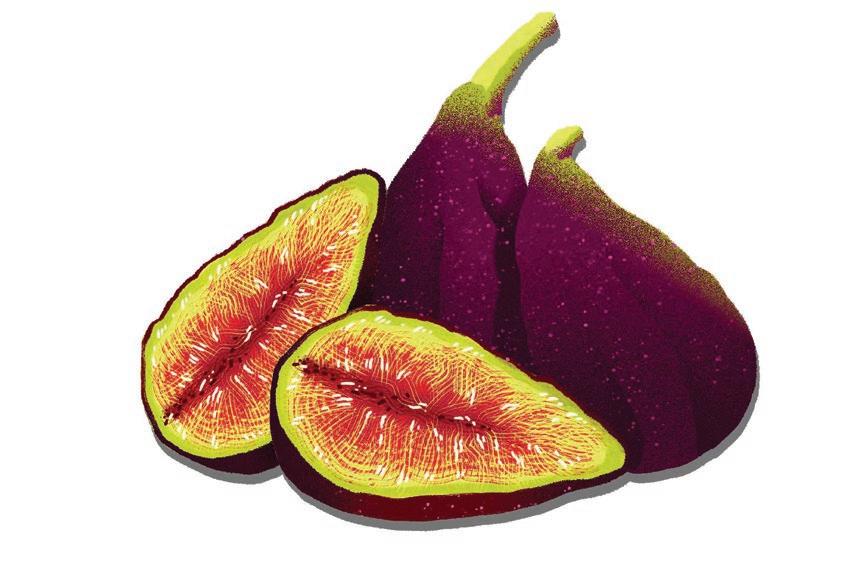
The addition of a small quantity of grappa enhances the crispness and fragrance, and a pinch of salt is a reminder of the ancient Styrian salt route that used to stop at the port on the Noncello River, which is now the city of Pordenone. Today, this speciality is still 100% artisan-made.
Small in size and with a very thin skin, the sweet FigoMoro fig owes its qualities to the special microclimate of the Pordenone foothills, between the Pre-Alps and the Friulian plain. The prohibition of chemical treatments on the plants of this particular black fig makes FigoMoro completely genuine and natural. It is harvested with its stem and should be eaten with its skin to fully appreciate
its flavour It was very famous in the days of the Venetian Republic, served at sumptuous banquets and also used as a power food when dried. The Alto Friuli Heirloom Apples, cultivated using sustainable techniques, are also highly recommended and a pleasant delight.

Figo Moro
Alto Friuli Heirloom Apples, a Slow Food Presidium.

In the enchanting mountain setting of the Arzino Valley, along the valleys of the Mònt d'Às, one of Friuli's most historically rich cow's milk cheeses is produced: Asìno. A product characterised by a unique and captivating taste. Due to its
savoury flavour, Asìno is also called “salty cheese.” Its name refers to the production area, on the right bank of the Tagliamento River, between Spilimbergo, Clauzetto and Vito d'Asio, in the province of Pordenone.


The DOC Friuli Grave wine district extends between the provinces of Pordenone and Udine: this area is characterised by stony soil of alluvial origin that, in addition to guaranteeing an ideal level of humidity, stores heat during the day and returns it to the vines at night.
Domanins / Pordenone

Prosciutto di San Daniele PDO, a concentration of delicacy and flavour in every slice.
San Daniele del Friuli is a destination for food and wine tourism that has always attracted lovers of the delicacy and flavour of its prosciutto. Of course, San Daniele is surrounded

by the magic of the rolling hills of Friuli, an unspoilt territory preserved by the people who live there, with its highly appreciated specialities and great wines. This, however, is not enough to explain the strength and prestige of the myth represented by a product whose qualities are celebrated in every corner of the world.

A centuries-old tradition that has made Prosciutto di San Daniele one of Italy's finest products, appreciated all over the world
The production of Prosciutto di San Daniele PDO is based on two simple ingredients: selected Italian pig legs and sea salt. However, it is the climatic characteristics of the territory and the expertise of the skilled artisans, who ensure the continuity of a production process that has remained unchanged for centuries that make this product of excellence so unique. Situated in the Tagliamento Valley, halfway between the Carnic Pre-Alps and the Adriatic Sea, San Daniele del Friuli stands on the slopes and at the foot of a moraine hill at 252 metres above sea level.


Here, the warm, salty breezes that blow up the Tagliamento River from the coast, gradually cooling as they meet the cold winds that descend from the Carnic Alps, create a gentle, constant ventilation that is essential for the curing of Prosciutto. This is why it is said that the secret of

San Daniele is San Daniele. If the Prosciutto is its most brilliant jewel, the historic city centre of San Daniele del Friuli offers some very good reasons not to miss this stop on your itinerary through Friuli Venezia Giulia. Not to be missed are the Church of Sant'Antonio Abate, a masterpiece considered the "Sistine Chapel of Friuli" thanks to Martino da Udine, who completed the project between 1497 and 1522; the Guarneriana Library, one of the first public buildings of its kind in Italy; the Portonat, a square tower built in 1580 by Andrea Palladio; and the Cathedral of San Michele Arcangelo, which was built in the year 1700.
Without nature and the people of the land where it was born, Prosciutto di San Daniele PDO would not be the great speciality we all know and love.
The Prosciutto di San Daniele Festival is celebrated every year in the summer in the town of San Daniele del Friuli. The event has attracted thousands of tourists and gourmets from Italy and abroad every year and it features a rich calendar of events and appointments that animate the streets and squares of the town from Friday to Sunday

San Daniele del Friuli / Udine
Live cooking, conferences, sensory workshops and visits to the Prosciutto factories are the highlights of a festival that, along with the beauty of the city, has featured the local establishments and stands as the main protagonists. In every edition, the other main stars of the rich gastronomy of the Region have also always been in the spotlight.



San Daniele PDO is born from the expert hands of master Prosciutto artisans who, through ancient knowledge and strict rules, transform meat and salt into a masterpiece of delicacy and flavour.
Recognised in 1970 with Italian Law No. 507 by the Italian State as a Denomination of Origin and in 1996 as a Protected Designation of Origin (PDO) by the European Union,
Daniele PDO exclusively in the town of San Daniele del Friuli. The production process, unchanged since its origins, includes: selection and trimming of the hind legs, salting, cleaning

Prosciutto di San Daniele PDO is characterised by its typical guitar shape and the presence of the trotter. This last detail, in addition to preserving the integrity of the leg, helps to remove moisture, which in turn facilitates the curing process. Since 1961, the protection of the brand and of Prosciutto di San Daniele PDO has been entrusted to the Prosciutto di San Daniele Consortium.
Founded by a group of producers, entrepreneurs and representatives of the local community, the Consortium brings together the only thirtyone companies authorised to produce Prosciutto di San
of the salt and subsequent pressing, resting, washing, drying and 'tempering' of the hind legs at medium temperatures for about a week, and lastly curing. During processing, a mixture of lard and cereal flour is applied to the part not covered by the rind to keep it soft.

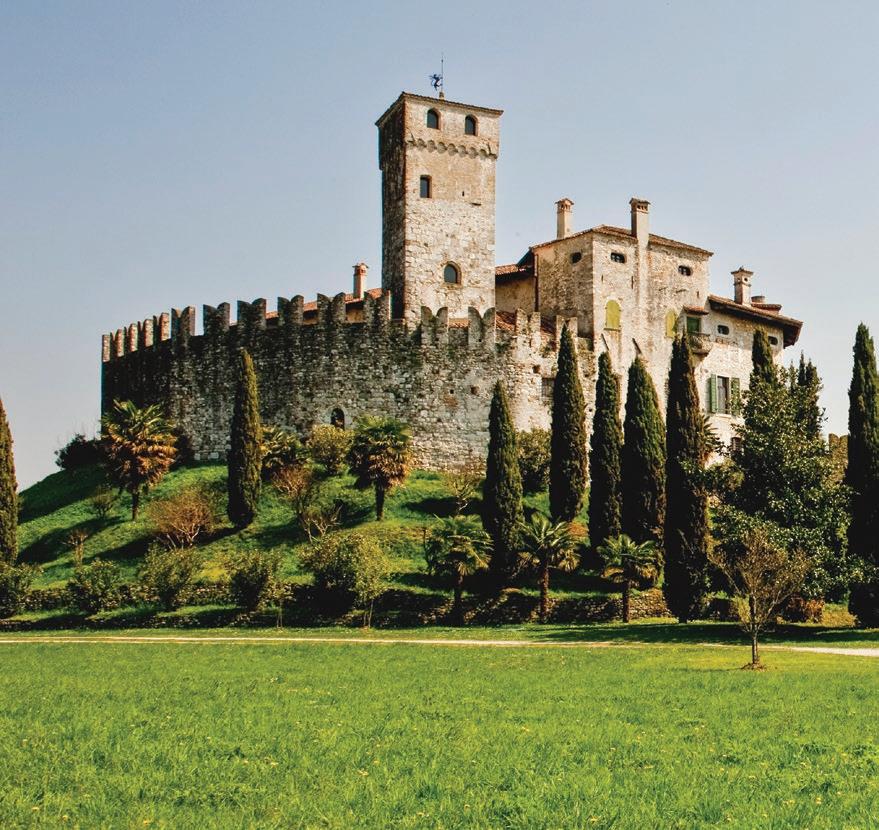
Latteria cheese is linked to the tradition of the "Turnaria" dairies, where families took turns delivering the milk that was then processed by the cheesemakers.
Latteria cheese could not and cannot be absent from the homes of Friuli Venezia Giulia. Its history is linked to a past rooted in the life of each household. Typical of this territory is the tradition of the "Turnaria" dairies, a method of managing the milk collection of the small farmers present in each village, which allowed the production of cheese on a small scale, but often of very
Castello di Villalta / Udine

high quality. If there are fewer farmers today, the same cannot be said of the cheesemakers, who continue to produce artisan cheeses that are in demand by consumers, delicatessens, taverns and restaurants. In fact, there are a few dozen dairies that maintain the reputation for excellence that has always accompanied Friulian cheeses.

Frico, the symbol of Friulian cuisine, is a cake made with potatoes and PDO Montasio or Latteria cheese.
Soft and stringy inside, it has a crispy crust and is served with a warm slice of polenta.

Its origin is uncertain and the dish features many variations. It is said to have been invented in Carnia to use leftovers from cheese shaping. In the most traditional and widespread version, it is prepared with onion, potatoes and PDO Montasio cheese of various ages, but other
ingredients are also added, such as pumpkin, herbs and cured meats. In addition to the soft version, there is also the crispy Frico, which is prepared with grated matured Latteria cheese that, when pan-fried, becomes a delicious crispy wafer.
Osteria Alla Ghiacciaia / Udine

There are many festivals dedicated to Frico in Friuli Venezia Giulia: in Fraelacco di Tricesimo, in Flaibano, in Oseacco di Resia and, around mid-August, in Carpacco, which is the most popular.
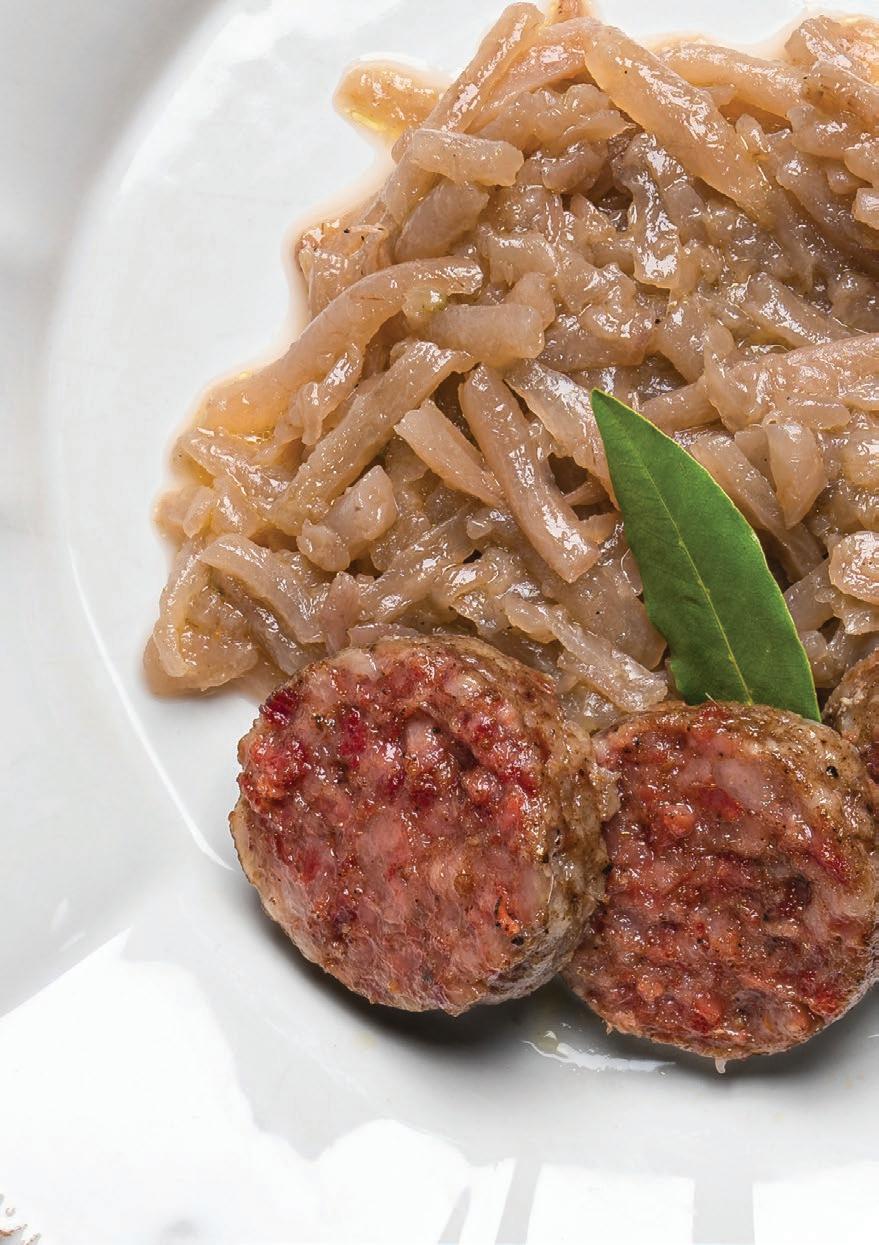

BROVADA PDO Ideal side dish for the irresistible Friulian Musetto

Brovada PDO is a side dish of rural tradition, whose recipe, based on simple and humble ingredients, also had the purpose of allowing it to be preserved for a longer period of time. The main ingredient of this typical Friulian dish is the purple-collared turnip, which, according to the traditional recipe, must be left to ferment with the marc in large vats. Early autumn is therefore the ideal time to prepare this traditional food. Thanks to its strong flavour, marked by a distinct acidity, Brovada is the perfect match for pork, boiled meat and one of the most classic dishes of this region: "Brovada e muset", where "Muset" is the Friulian version of Cotechino, prepared with lean cuts, including the pig's snout, from which it takes its name.
The water from Carnia or the Friulian Dolomites is what makes it possible to produce outstanding craft beers.
The purity of the water used, which very often comes from Carnia or the Friulian Dolomites, is one of the main elements that allows the craft breweries of Friuli Venezia Giulia to create brews that go perfectly with the specialities of the Region. Some brewers are also proud to cultivate the barley and hops


that are used as the foundation for their beers. Each brewery is inspired by a different school of thought, reinterpreting its dictates with style and passion. The combination of these elements and characteristics contributes to the creation of unique and unrepeatable products, thanks above all to the
master brewer, who is responsible for balancing the aromas and taste of the recipes. A visit to these craft breweries, whose addresses are listed in the Wine and Taste Route of Friuli Venezia Giulia guide, will give you the opportunity to discover and taste a wide variety of beers, rich in surprising nuances.

Side picture
The breweries in the Region offer a wide variety of beers brimming with a variety of different flavours
Top picture In many cases, the barley and hops are grown by the craft brewers themselves
Pork
is a traditional staple of the
gastronomic tradition of
Friuli Venezia Giulia and the source of a great variety of dishes and recipes
Historically, in the Friulian countryside, pigs were bred in every home providing an essential source of protein for families. During the months of November to February, skilled pork butchers produced delicious cold cuts and sausages. Although domestic pig breeding has almost disappeared, the tradition of pork farming has not been lost, and today it is possible to taste the typical Friulian salami, made from selected meat mixed with lard and spices, the classic sausages, the Sopressa, the Pancetta, the lard, the Marcundela and the Musetto in local restaurants.
Given the importance of pork in the traditional diet of the people, the creativity of cooks and chefs has over time created dishes such as salami with vinegar, the Cicciole with radicchio, barley and beans with pork rind, boiled feet and bones and baked shin. Dishes that are reminiscent of a more calorie-rich life than today, but that preserve the flavour of a world that still attracts people today for its simplicity and authenticity.
1 Guanciale; 2 Coppa; 3 Shoulder; 4 Ribs; 5 Chops; 6 Lard; 7 Loin; 8 Fillet; 9 Pancetta; 10 Thigh

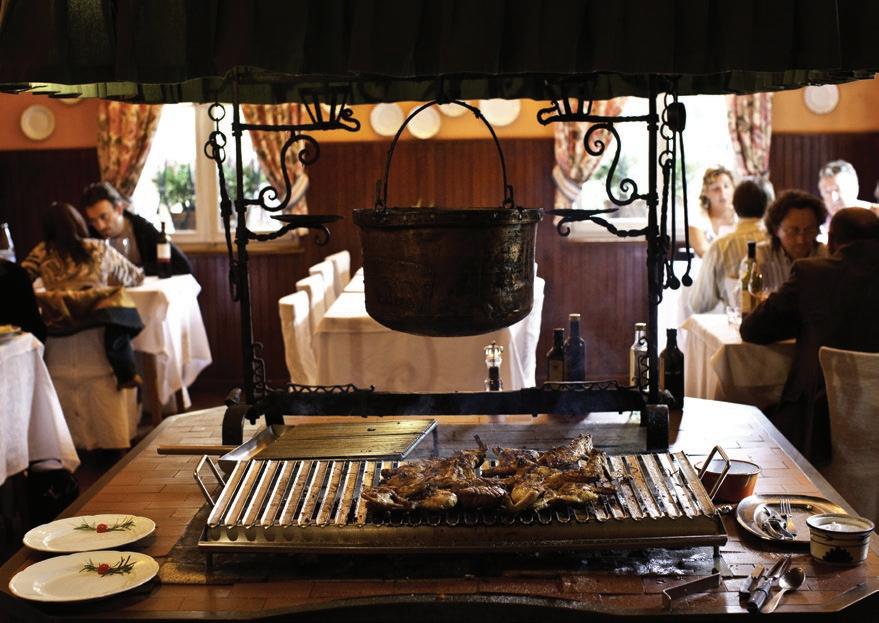
The heart of the typical hospitality of this land is found around the Fogolâr, which means the hearth

The grill and the Fogolâr are complementary and inseparable parts of the atmosphere. A promise to make guests feel at home. A promise that you breathe in the moment you enter a traditional Friulian Trattoria. Add to these qualities the mastery of the restaurateur, who knows how to transform steaks and sausages into masterpieces of flavour and tenderness with calculated movements. The gestures and concentration of the person in charge of the grill give this person the air of a guru, suggesting that the delicacies the cook knows how to prepare over the coals are also the result of a magical ritual.

The Pestàt di Fagagna is a mixture of minced lard, spices and aromatic herbs stuffed into a pork casing or preserved in glass jars after 30 days of ageing. It is used to add flavour to soups or meat dishes.
The idea behind the recipe is to preserve the aromas of the herbs during the winter by trapping their fragrance in the lard together with salt and pepper.

Side pictures
The Fogolâr is often the protagonist in local restaurants, and so is Friulian
Top pictures
A dish prepared with the Pestàt From
Pestât di Fagagna
salami
Fagagna.

THE OSTERIA,
A CLASSIC OF HOSPITALITY IN UDINE

The Osteria in Friuli is an institution, a place where you can feel at home, a living being with its own balance. Here everything takes on a dimension of relaxation and even time slows down, taking on the rhythms of ancient times
Historic, contemporary, simple or more refined, quiet or noisy, there is no street or square in Udine that does not harbour an Osteria, each with its own character, its own atmosphere, its wine list, its snacks and, sometimes, traditional hot dishes.



In front of a glass of wine, social classes disappear, spirits are relaxed, friends meet and hearts grow warm. On the blackboard or in the words of the host, the main characters are the names of the wines and cellars that the restaurant has on offer by the glass, as an alternative to the house white or red.
The wine list by the glass is always displayed on a blackboard on the wall of the restaurant.


When the weather is fine, the indoor areas are complemented by outdoor tables that stretch into the streets and squares of Udine.
There are many taverns in Friuli, which are called Osterie. Some of them have been transformed into cafés or wine bars, with modern furnishings and a refined atmosphere, but the most beautiful remain those that have preserved the traditional style, perhaps with
Piazza San Giacomo / Udine
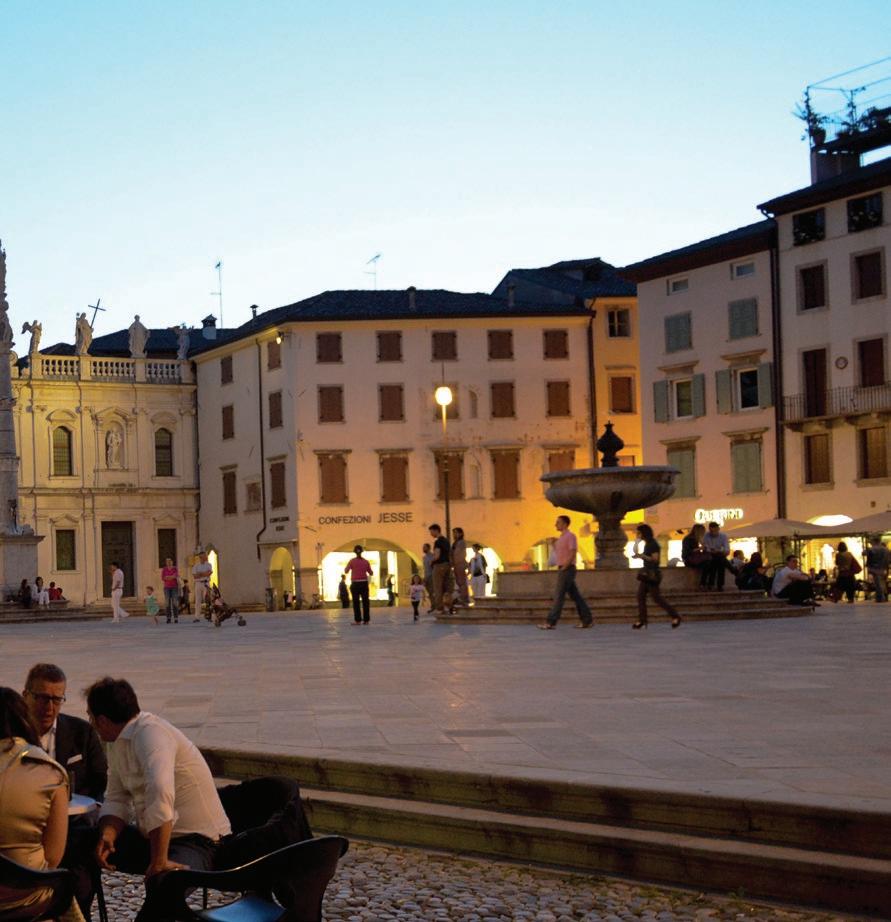
the Fogolâr in the centre of the room, where simplicity, a warm welcome and careful regard for the territory are the cornerstones of hospitality. Many of these establishments are renowned for their excellent cuisine and wine cellars, as well as their spirit in tune with tradition.


Friuli DOC is an event to savour, an opportunity to discover the soul of a territory that has remained authentic and faithful to its traditions.
At the beginning of September in Udine, Friuli DOC is an opportunity to discover, in a burst of emotion, the soul of a territory that has remained authentic and faithful to its roots and traditions. A land where the art of making good food has been handed down from generation to generation and where sharing it is a genuine pleasure.

Piazza del Castello in Udine during an edition of Friuli DOC.
During Friuli DOC, the taverns, called Osterie, are the soul of the event, with their wine, the typical ingredients of the region and a sincere and rich human conviviality.

In an Osteria, the menu expresses the identity of the Region and the tavernkeeper becomes its ambassador, choosing wines and specialities from the producers of the surrounding villages. An Osteria is a place for everyone, where simplicity and authenticity are the watchwords, a symbol of Friulian hospitality..
The Osteria of Friuli in just a few words
A warm, cosy and authentic atmosphere where traditions are preserved. A few dishes, carefully prepared. Reasonable prices. Wines from the surrounding territory, with the most representative labels, some
sparkling wines, and a handful of premium bottles. The skilled host knows how to find and suggest specialities from the smaller local wineries and food producers. An Osteria revolves around its regular clientele, guaranteeing tourists an authentic place in terms of wine cellar, cuisine and atmosphere.

Frico with polenta
The
absence of colour and the delicate flavour of the White Asparagus of Tavagnacco are the result of a cultivation method which keeps the asparagus covered and protected from the light until it ripens
Like little soldiers at the service of the culinary prestige of the Region, the White Asparagus of Tavagnacco has a curious and peculiar history. It is said that, at the end of the 19th century, due to a problem of excessive humidity in the soil where vines were


cultivated, it was decided to plant asparagus seedlings between the rows. The plant immediately found its ideal habitat in the terrain of Tavagnacco, so much so that in time it eventually replaced the cultivation of vines. The absence of colour and the delicate taste of this asparagus variety are the result of the
Asparago bianco

cultivation method, which keeps the asparagus covered and protected from the light until it ripens. Since 1935, in the month of May, Tavagnacco has celebrated the "Asparagus Festival", the most famous and longest-running festival dedicated to this crop in Friuli Venezia Giulia. Both innovative and traditional recipes are featured, with the white asparagus playing a leading role.
These dishes find the perfect pairing with excellent local wines. The White Asparagus of Tavagnacco is also a delicacy simply boiled and served with extra virgin olive oil, a pinch of salt and pepper, and hard-boiled eggs. Also not to be forgotten are the Asparagus of Fossalon and the other asparagus varieties grown in several other areas of the Region.
Side picture
The cultivation of the white asparagus of Tavagnacco
Top picture Simplicity and quality ingredients: a tasty dish with asparagus and eggs

Legends ALDO MORASSUTTI
For generations, the absolute model and leading figure of traditional Friulian hospitality
Aldo Morassutti, the unforgettable owner of the "Da Toni" restaurant in Gradiscutta di Varmo, was for generations an absolute reference

point for traditional Friulian hospitality, where substance and simplicity were the order of the day. Dining at "Da Toni" was like entering the authentic spirit of Friulian tradition, a world that Aldo knew how to interpret, update and revise with style, discretion and the magic touch of a great professional. A large restaurant where, in the centre of the main hall, you could not miss the Fogolâr for grilled meats.
Aldo Morassutti, an elegant host and perfect ambassador of the cuisine of Friuli Venezia Giulia
Aldo knew how to interpret, update and revise the authentic spirit of local food and wine with style, discretion and the magic touch of a great professional

Aldo Morassutti was not a chefhe was flanked in the kitchen by the excellent Marco Liani - but an innkeeper who was able to give his guests a unique touch of class in his restaurant in Gradiscutta, a small village in the green Friulian plain, a land of rivers and resurrections.

Maria Theresa of Austria's decision to exempt producers from taxes on distillation was the initial spark. Since then, distilleries have proliferated throughout the region, contributing to the development of the local economy. In the 19th century, distillation methods were refined with the invention of the first column still and the perfection of steam distillation. This represented a major breakthrough, since to this day most grappa is still distilled using this method.
In 1973, the world's first single-varietal grappa was created by a distillery in the town of Percoto, in Friuli Venezia Giulia.

In the 19th century, distillation methods were refined and perfected
Top picture
A toast between Luigi Veronelli and the young Giannola Nonino
An icon of the Region, grappa became popular in the Habsburg Empire when Maria Theresa of Austria exempted producers from taxes on distillation

Traditional grappa was made from the marc of many different grape varieties, but in 1973 the historic distillery in Percoto, a town in Friuli Venezia Giulia, revolutionised the system of grappa production in Italy, creating the first single-varietal
grappa by distilling the pomace of Picolit grapes separately. This new production method transforms grappa from a rough drink into the queen of spirits, making it one of the most famous and appreciated alcoholic beverages in the world.
Grappa Friulana

With its historical significance, Polenta is also a traditional ingredient in Friuli Venezia Giulia. An essential side dish for tasty meat courses, polenta is never wasted and can be enjoyed even after several days by reheating it in a frying pan or the oven.
In the past, Polenta was a reliable meal for many families in Friuli Venezia Giulia, and it has become a characteristic and constant part of everyday culinary traditions. It is commonly served as a starter, for example, toasted with a slice of Musetto; as a first course, from Polenta e milk to Polenta and beans; as a main course, such as Polenta and stockfish or Polenta and hare; and always as the first and most important side dish. In Friuli Venezia Giulia, it is also served as an alternative

to bread or, combined with other ingredients according to individual family traditions, in the previously mentioned Toç in braide.
Side picture
Corn flour, the base ingredient for the classic polenta from Friuli
Top picture
Some hot polenta is the perfect match for a meal which includes game meat
GORIZIA, A TOAST TO THE FLAVOURS OF CENTRAL EUROPE

Gorizia is a jewel set in a crown of vineyards where some of the finest Italian white wines were born. The cuisine of this city, with its many cultural influences, is the perfect complement to such highquality winemaking.

The Gorizia Rose Radicchio, a delicacy for the most demanding palates, is a permanent fixture in the kitchens of the starred restaurants of the territory.
The tradition linked to this bright red Rose has been handed down for two centuries and it enriches and adorns the kitchen during the winter. This is a particularly prized red radicchio, mentioned in 1874 by the Habsburg state

official Karl von Czoernig in his treatise focusing on Gorizia. It is cultivated in limited quantities and processed according to secret methods to obtain this crunchy delicacy with an intense, slightly bitter flavour.
A delicacy for the most demanding palates, it is a permanent fixture in the kitchens of starred restaurants and on the tables of Friuli Venezia Giulia.
SMOKED GOOSE BREAST
Goose specialities, a real gourmet choice.
Smoked Goose Breast
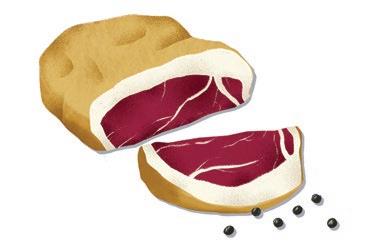
Goose has always been present in the gastronomic tradition of the Region, and smoked goose breast is one of the most popular charcuterie products made from this meat. The smoking process involves the use of moistened beech wood, a choice that adds an extraordinarily pleasant and distinctive flavour to the goose breast. Before smoking, the breast is salted, seasoned and stuffed. The result is a product with a delicious flavour that is traditionally served on special occasions.


ANTONIA KLUGMANN
Chef of the “L'Argine a Vencò” restaurant, which has been awarded a Michelin Star
Discipline, attention to detail and passion are the ingredients that define Antonia Klugmann's cuisine. The "L'Argine a Vencò" restaurant was awarded a Michelin Star in 2014, just a few months after its opening. It is located in the
middle of a forest, in the village of Dolegna del Collio, in the province of Gorizia close to the border with Slovenia. Antonia had, however, received a Michelin Star a year earlier as the chef at the Venissa in the Lagoon of Venice.


Born in Trieste - she is also a sailing instructor - but of Apulian, Emilian and Jewish descent, Klugmann's approach to cooking is not to replicate regional traditions but to be consciously open to the future.
Her dishes, harmonious and precise, feature a great use of vegetables, although the chef is also a master of cooking seafood and meat, as well as desserts. She was also one of the judges in a season of MasterChef Italy, the only woman on the panel.

Harmonious and precise dishes that feature a great use of vegetables. The menu also includes seafood and meat, as well as desserts, all of which are prepared by skilful hands.
L'ARGINE A VENCÒ
Località Vencò 34070 Dolegna del Collio Gorizia
A JOURNEY THROUGH THE SEAFOOD SPECIALITIES OF FRIULI
VENEZIA GIULIA


When it is time to sit down at the table, the choice is as varied as ever, both in terms of selecting the menu and the type of establishment, from the "Casoni", the starred restaurants, to the characteristic taverns known as "Trattorie"
Speaking of cuisine, our advice is to choose the local catch, which is known for its high quality. Enjoy your meal with the excellent
white wines of the Region. The most popular fish served at the table include sole, flounder, umbrine, seabream, dentex, gilt-head bream, white seabream and sea bass. Recipes using tender squid, cuttlefish and mantis shrimp, known as "Canoce", as well as scampi, prawns, brown crab and lobster, are also exceptional.
Top picture
Cycle routes, a natural way to discover the coastline of Friuli Venezia Giulia
Side picture Fried fish and shellfish, perfect with a glass of Friulian white wine
Lignano Sabbiadoro / Udine
In a hypothetical itinerary from west to east, we start from the mouth of the Tagliamento River and the town of Lignano Sabbiadoro, with its variety of venues, some of which can be reached by the cycle route that runs along the seafront under the maritime pines. Here you can enjoy fresh seafood, shellfish and molluscs prepared according to tradition, in a simple way that does not cover up their true flavour.


In Marano, just before the Ferragosto holiday in mid-August, the “Festa dei Fasolari” festival is the perfect opportunity to enjoy and taste delicious smooth clams.

We move on to a new landscape and reach Marano Lagunare, where a handful of small islands of striking beauty guard a Venetian-style historical centre. On these small oases of emerged land, fishermen built the typical lagoon dwellings, known as "Casoni", which have been permanently inhabited since the early 1900s. In Marano, in the days leading up to the Ferragosto holiday in mid-August, the "Festa dei Fasolari" festival is held, during which delicious soft clams are prepared in a variety of different recipes, together with mussels, clams and scallops, all of which are caught in the Lagoon.
Fasolari
Marano Lagunare / Udine
Eel, a typical speciality of the Venetian and Friulian lagoons, which is still cooked over a flame in the "Casoni", deserves a special mention. The recipe for this delicious dish calls for the eel to be cut into pieces and gently roasted over the coals for several hours, using laurel branches as skewers, until it is crispy on the outside and soft on the inside.
Eel, a typical lagoon speciality, is traditionally cooked on a spit.

Side picture
Strolling through the characteristic town centre of Marano Lagunare
Top picture Spit-roasted eel, a typical delicacy of the Lagoon.

Boreto a la graisana, the signature dish of the cuisine of Grado is prepared with a few simple ingredients: slices of fish, oil, vinegar, salt and pepper
We travel on to Grado where, after a boat ride and a walk through the characteristic old town, we can enjoy Sarde in saor and, above all, Boreto. A humble but really tasty dish, made with freshly
caught fish cut into slices, EVO oil, salt and pepper. All of these ingredients are then sautéed in a pan with a glass of vinegar.
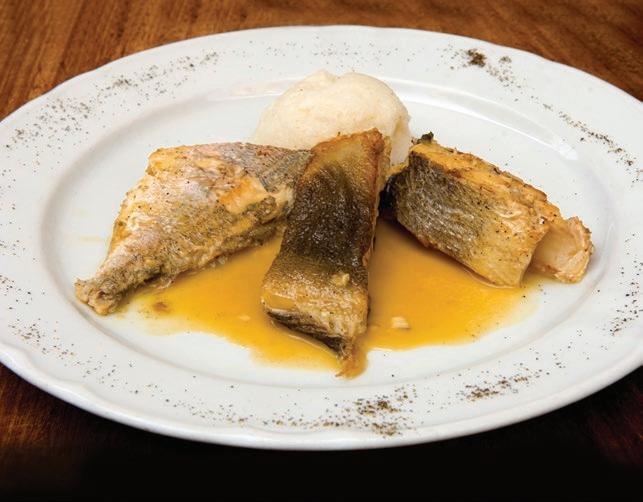
Side picture
The entrance channel to Grado harbour with the boats of the fishermen
Top picture
A portion of Boreto, the signature dish of the cuisine of Grado

The
coast of Friuli
Venezia Giulia offers a magical and spectacular ecosystem: the Grado and Marano Lagoon
A world of its own, stretching from the village of Fossalon to the island of Anfora, at the mouth of the Ausa and Corno rivers. Here, until the 1960s, many families lived permanently in the "Casoni", typical dwellings with thatched and reed roofs built on the islets scattered
The Grado Lagoon /

around the lagoon. Characterised by a simple, functional design and the use of building materials taken from the river and lagoon environment, these examples of ancestral architecture are now an everlasting and integral part of the landscape.

Welcome to Muggia, a charming fishing village nestled in a small bay on the
Gulf of Trieste

Follow the Adriatic for a few kilometres and, past Monfalcone, you will reach the coastal road to Trieste, the capital of Friuli Venezia Giulia and a magnificent city overlooking the sea. An essential part of the traditional local cuisine are fried Sardoni (the word means “sardines” in the local dialect of Trieste), served both as a starter and a main course.
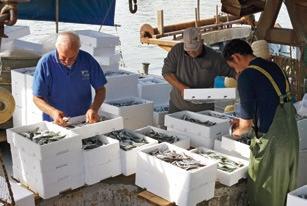

Top picture
Fishermen from the Gulf supply the seafood restaurants of Muggia on a daily basis
Muggia / Trieste


Fried Sardoni are an essential part of the traditional cuisine of Trieste
Another typical recipe of the city is the Pedoci a scotadeo, which are mussels cooked without the addition of sauce. A simple and delicious dish. The last stop on our seafood itinerary is Muggia, a charming fishing village on the bay of the same name in the Gulf of Trieste. We are located in the eastern and southernmost tip of Friuli Venezia Giulia, on the border with Slovenia: the right place to taste a dish that is part of the Istrian tradition, Scampi alla Bùsara, which we suggest you enjoy with a glass of Vitovska del Carso.
Top picture Sardoni fritti (fried sardines), a classic Trieste dish

AMONG THE BUFFETS AND CAFÉS OF TRIESTE, DISCOVERING UNFORGETTABLE CULINARY DELIGHTS

The buffet is the classic place to stop for a Rebechin, which in the dialect of Trieste means the mid-morning snack that the harbour workers used to enjoy when hunger began to kick in, but also the place to take shelter in winter when the Bora wind strikes



The aroma of warm Prosciutto baked in a bread crust, with mustard and horseradish root. The fragrance of Liptauer, the creamy Austro-Hungarian cheese made from sheep's milk ricotta and paprika. We are in one of the typical buffets of Trieste, a characteristic establishment where people can eat warm
and delicious food at any time. Breaded and fried aubergines and courgettes, fragrant boiled meats, frankfurters with sauerkraut, sausages with horseradish and mustard, Goulash, and Jota, the typical sauerkraut soup, are just some of the specialities to be found in these historic city restaurants.
Side picture
The life-size statue of James Joyce in Ponterosso Square
Top picture
A mouth-watering dish of “Bollito misto alla Triestina”, the famous cauldron
The aroma of warm Prosciutto baked in a bread crust with horseradish root, welcome to a buffet in the city of Trieste

And it is impossible not to mention Porcina, a boiled pork sausage, served warm with horseradish and mustard, possibly paired with another city icon: Patate in tecia, which are potatoes boiled, seasoned and cooked in a pan.

The Jota is a soup of very ancient origin made with beans, potatoes, cabbage and chunks of pork, typical of Trieste and its plateau. The last variation of the recipe dates back to when potatoes were introduced into Europe after the discovery of America. Until then, the main ingredient was Capuzi garbi, the local name for strips of fermented sour cabbage with a very strong flavour that enriched a soup made with a handful of beans and a few pork bones.
Today, the recipe has been adapted to modern tastes, while retaining its typical intense and rustic flavour. The addition of potatoes, mashed together with Borlotti beans, with a Prosciutto bone, pork ribs and some sausages, depending on the availability of the pantry, make it a unique, warm and hearty dish.
Jota

Trieste is the city of coffee. A relationship that began with the shipping companies, developed with the first coffee roasters and was completed with the historic cafés that grace the city. It was in these places that Italo Svevo, James Joyce, Umberto Saba and Stendhal found their inspiration.
The historic cafés of the city are definitely worth a visit, especially the Tommaseo, dating back to 1825, and the Caffè San Marco

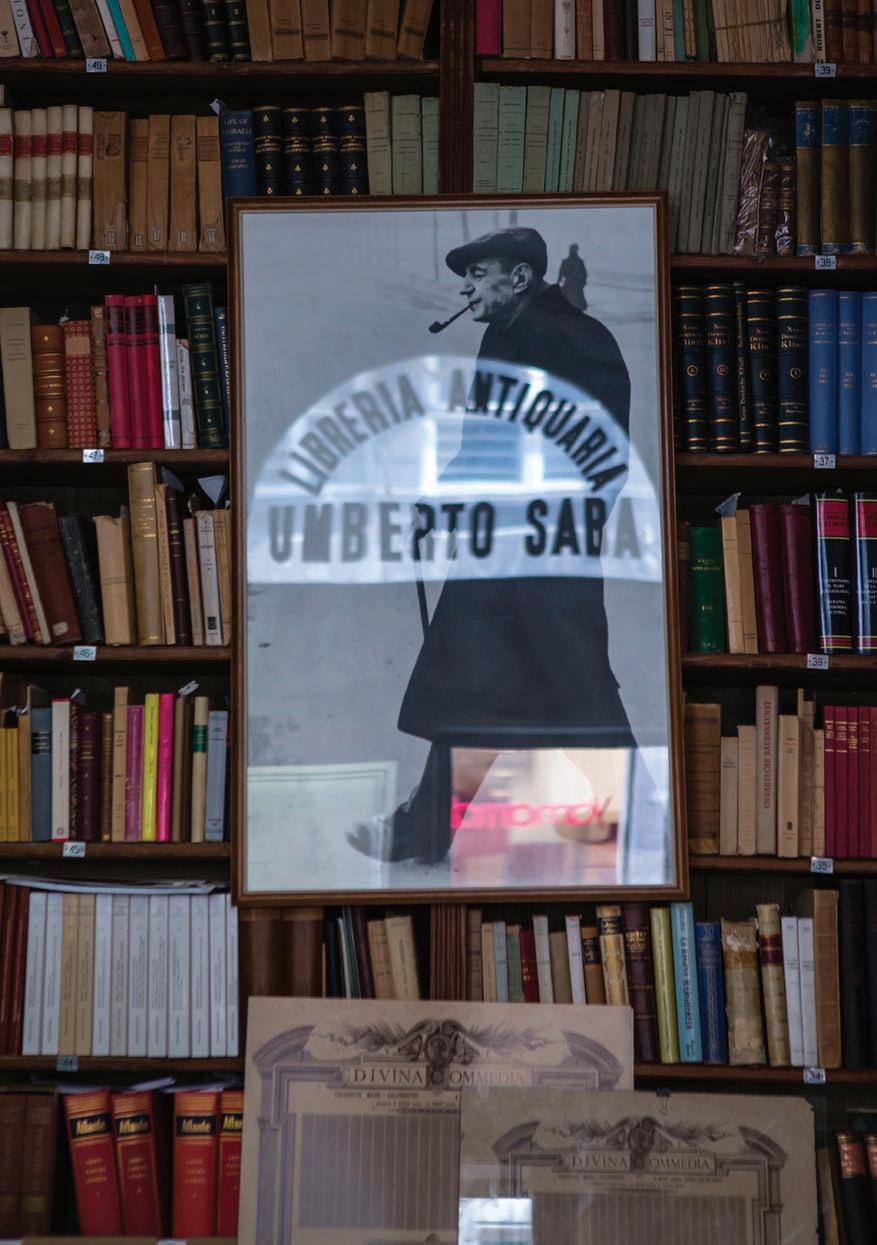
The historic cafés of the city are definitely worth a visit, including the Caffè Tommaseo, the oldest, dating back to 1825. The Caffè San Marco was opened in 1914 and has recently been restored to its original beauty. Last but not least, if you wish to step back in time to the era of Princess Sissi, you should certainly visit the Caffè degli Specchi in Piazza Unità d'Italia. Originally founded in 1839, it is the only surviving café of the four that once competed for the best customers in what was then called the Piazza Grande

The Putizza is a very popular dessert and its recipe has been handed for generations in the recipe books of every family.
While the Gubana of Gorizia was originally an aristocratic dessert, a trace of which can be found in a poem dedicated to the city of Gorizia in 1714, the Putizza is a popular dessert handed down in rural recipe books. Its snail-like shape makes it unmistakable, and so does the addition of chocolate, which is not the case with gubana Some of the filling ingredients include honey, grated orange and lemon peel, rum and dried fruit. Discovering all the differences between these two desserts is an exercise of genuine pleasure.

Putizza
Piazza Unità d'Italia / Trieste

A filling of dried and candied fruit, honey and raisins in a puff pastry case and the Presnitz is served
The sweet is very popular in Trieste and all over the Karst region and is a regular dessert on the tables of the city, especially during the festive season.
Legend has it that the recipe was created for a confectionery competition held on the occasion of the visit of Emperor Franz Joseph and his wife Elisabeth of Austria, the famed "Sissi".

The original name of Presnitz was "Preis Prinzessin", which was later shortened for convenience.

In the 18th century, an imperial decree granted winegrowers in the Karst region eight days to sell their wine in bulk. This is how the tradition of the Osmiza was born, thanks to this initiative promoted by Maria Theresa of Austria.
An Osmiza is a typical house of the Karst that, at certain times of the year, offers homemade wines and specialities of the Karst cuisine, such as homemade cold cuts, typical cheeses, eggs,
omelettes, beef cheek cooked in Terrano wine, potato dumplings, pork shoulder in bread crust and roasted bacon. These improvised establishments can be recognised by a characteristic wooden sign with an ivy branch hanging from it, a sign that you are near an open Osmiza. You will be enchanted by the unique character of these private establishments and by the beauty of the Karst.
Top picture
The rocky nature of the Karst has an influence on the development of its distinctive and spectacular vegetation
Side picture
Cured meats and cheese, often homemade, are accompanied by a glass of characteristic Terrano wine


Despite the fact that the Karst is characterised by rocky surfaces, depressions, caves and caverns, all of which represent a serious obstacle to agriculture, wines of great quality are produced here, thanks to the heroic efforts of the local producers. The Karst soil is characterised by the fact that rainwater drains away very quickly, leaving only part of it to be retained by the scarce red Karst land. This type of terrain gives the

wines compact and deep colours, intense and varied aromas, mineral sensations, excellent structure and the ability to evolve.
Top picture
On the Karst, cellars are often excavated in the rock
Top and side picture
A plate of Jota. Tables prepared to welcome guests in the garden of an Osmiza
The territory produces wines such as the Malvasia - elegant, dry and very savoury -, the Vitovska, also known as the Queen of the Karst - savoury, dry and very mineral - and the famous Terrano, ruby red with violet reflections,
with aromas of raspberry and blackberry, characterised by lively acidity and limited tannin content. It is worth noting that the focus on sustainability has long been prevalent in these winemaking communities.

Homemade wines and specialities of the Karst cuisine are served in the Osmize
The mountains, the water, the green hills, the Karst sinkholes, the plains, the territory of the Magredi and the sea all create a habitat of great diversity from which the beekeepers of the region harvest extraordinary honey. Marasca honey and red ailanthus honey, produced on the Karst plateau, are among the most appreciated.

Marasca honey

The hinterland of Trieste and the Karst plateau offer views of incomparable beauty. And there is more
Tergeste PDO extra virgin olive oil is also produced in the Karst. The olive tree has been present in the territory surrounding Trieste since before Roman times, under the soothing influence of the Adriatic Sea.

This cultivation has probably been favoured by the excellent organoleptic characteristics of this product, with its delicate and enveloping flavour, often marked by notes of green tomato.

Olio tergeste
A GUIDE TO DISCOVER THE ESSENCE OF THE TERRITORY
An extraordinary journey along six routes in search of the best when it comes to hospitality, wineries, gastronomy and artisan products in one of the most exciting Regions of Italy when it comes to food and wine. Almost 400 pages featuring restaurants, wine cellars, craft breweries, the outlets of small producers as well as all the available tourist services to help you plan unforgettable days of good living.
Download the guide by scanning the QR Code and visit www.tastefvg.it

A FASCINATING JOURNEY
ACROSS SIX ITINERARIES

HERE IN OUR KARST PLATEAU
The splendour of Trieste and the unique nature of the Karst plateau in the discovery of Central European flavours, the osmize, cafes and historical buffets.

HERE IN OUR RIVER
Life is concentrated along the rivers with delicacies such as salmon trout, Grave wines and artisan products inspired by tradition.

HERE IN OUR HILLS
An exciting full immersion in the discovery of magnificent wine cellars, the Prosciutto that has conquered the hearts of gourmets the world over, as well as the many other products of this magnificent territory.

HERE IN OUR COAST
From Lignano Sabbiadoro to Monfalcone and beyond, from Hemingway to Biagio Marin, among lagoons, beaches and rocky coastlines to encounter tasty and refined seafood dishes.
HERE IN OUR MOUNTAINS
A route leading to destinations where the pleasures of the table are king. Among pastures, wild herbs, ancient recipes, clean air and extraordinary landscapes.


HERE IN OUR PLAIN
In the heart of Friuli Venezia Giulia, history and art blend with the unique hospitality of the osterie, atmospheric trattorias and specialities such as asparagus, frico and special pork delicacies.
THE ITINERARY
No matter where you go, you are on the right track
THE MAP
All the Municipalities that offer one or more of the recommended locations and their address
San Pietro al Natisone
THE CATEGORY
Producers, wineries, restaurants and services are listed and classified by type
Wine, Spirits & Beer
Birrificio Artigianale Dimont / Arta Terme
Birrificio àgro / Aviano
Rive Col de Fer / Caneva
Birrificio Artigianale Casamatta / Enemonzo
Birra Garlatti Costa / Forgaria nel Friuli
Birrificio Foglie d’erba / Forni di Sopra
Birrificio Agricolo Gjulia / San Pietro al Natisone
Zahre Beer / Sauris
Tenuta Fernanda Cappello / Sequals
Birrificio Artigianale Bondai / Sutrio
Restaurants
Grand Hotel Gortani Wellness & Relax / Arta Terme
Malga Montasio / Chiusaforte
Hosteria Al Kolovrat / Drenchia
Bar Trattoria Julia / Erto e Casso
Albergo Ristorante Al Sole / Forni Avoltri
La Baita dei Sapori / Malborghetto-Valbruna
Rifugio Valinis / Meduno
Agriturismo Al Tulin / Montenars
Al Castelu / Montereale Valcellina
Casa Valcellina / Montereale Valcellina
Edelweiss Ristorante Pizzeria / Piancavallo
Agriturismo Naunal / Priola di Sutrio
Indiniò Ristorante Bar / Raveo
Agriturismo Péstrofa / San Pietro al Natisone
Monte del Re / San Pietro al Natisone
Ristorante Mondschein / Sappada
Albergo Ristorante Riglarhaus / Sauris
La Casa delle Rondini / Stregna
Baita da Rico Sas / Sutrio
Al Buon Arrivo / Tarvisio
Hotel Ristorante Valleverde / Tarvisio
Locanda Mandi / Tarvisio
THE SYMBOL
The icon that appears throughout the guide identifies the addresses of that specific category
THE LOCATIONS
All the towns, villages and locations are listed in alphabetical order so you can easily find the addresses closest to you
THE NOTICES
Important information, services and special announcements
Cavasso Nuovo Via Località Mas, 5 33092 Cavasso Nuovo PN T. +39 3517035451 info@aziendacarusone.it
THE CATEGORY
The symbol that helps you recognise the category of an address
Cavasso Nuovo Via A. Moro, 3 33092 Cavasso Nuovo PN T. +39 348 6611047 agricolacarpenedo@gmail.com
Azienda Agricola Carusone Sandra Azienda Agricola Gianni Carpenedo
m lun-ven: 9-12 / 14-19 sab: 9-16; dom: 9-13 LINGUE: EN
Nel 2012 apre l’Azienda Agricola Carusone Sandra. Partendo dalla cipolla, da subito ha ampliato la sua produzione con anche altri prodotti (Frico Polenta ecc). Nel 2019 entrano in società anche Marica e Sasha, figlie di Sandra, ma soprattutto giovanissime, che vogliono supportare la madre e portare un po’ di ventata fresca in azienda. Iniziano un avviamento all’agricoltura biologica e biodinamica progettando frutteti e vigneti nella sede collinare dell’azienda, situata in Località Mas Cavasso Nuovo.
PRODOTTI
Sott’oli, sott’aceti, frico, polenta, cipolla, confetture, composte, scrioppi.
THE PRODUCTS
The list of products available (only for farms and wineries)
m lun-dom: solo su prenotazione LINGUE: EN
L’attività che identifica l’azienda è la coltivazione della Cipolla Rossa di Cavasso Nuovo (Presidio Slow Food), un prodotto dalle preziose proprietà organolettiche che viene proposto nella tradizionale e inconfondibile presentazione a treccia. Il caratteristico sapore dolce e delicato rende questa cipolla unica rispetto ad altre varietà. Recentemente l’azienda, a conduzione familiare, ha ampliato la produzione alla coltivazione di altre varietà di ortaggi e frutta autoctoni quali zucche, mele antiche e noci.
PRODOTTI
Composta di cipolla rossa e prugne, composta di cipolla rossa e arance, cipolla rossa in agrodolce, salsa di cipolla rossa e pomodoro, formaggi affinati con cipolla, frico con cipolla rossa.
www.agricolacarpenedo.com www.aziendacarusone.it
ON THE WEB
For more in-depth information online
Chiusaforte Altopiano del Montasio - Sella Nevea 33010 Chiusaforte UD
T. +39 334 6280290 malgamontasio@aafvg.it
Malga Montasio
Agriturismo
m lun-dom: 8-20
Aperto da giugno a fine settembre
FASCIA PREZZO: fino a € 20
COPERTI: 40 interni - 40 esterni
LINGUE: EN; DE
Situata sull’omonimo altopiano tra i 1.500 e i 1.800 metri sul livello del mare, Malga Montasio è sito di interesse comunitario, e si estende su un territorio di 1.064 ettari - di cui metà dedicati al pascolo - nel contesto delle Alpi Giulie, circondata dalle maestose catene del Canin e del Montasio. Le strutture della malga, tipiche degli alpeggi della montagna friulana, comprendono ricoveri per il bestiame, casere a uso abitazione per i pastori e un nucleo centrale con latteria, spaccio per la vendita dei prodotti lattiero caseari, ristoro agrituristico e alcune camere. La malga è raggiungibile da Chiusaforte - Sella Nevea - Altipiani del Montasio, oppure da Tarvisio - Cave del Predil - Sella Nevea - Altipiani del Montasio, percorrendo una strada asfaltata con auto o camper. L’azienda copre tutta la filiera agro-zootecnica che va dall’allevamento, alla caseificazione del latte derivato, alla vendita dei prodotti stessi, agriturismo e pernottamento.
THE ADDRESS
Geographical reference points to reach your destination, as well as telephone and e-mail contacts
Drenchia Fraz. Clabuzzaro, 8/A 33040 Drenchia UD T. +39 0432 721104 osteriaalcolovrat@libero.it
Hosteria Al Kolovrat
Ristorante tipico
m ven-dom: 10-21 (da Pasqua a Natale) lun-dom: 10-21 (luglio-agosto)
FASCIA PREZZO: € 20-30
COPERTI: 15 interni - 20 esterni
LINGUE: EN; SL
Affacciato sulla Valle dello Judrio e sulla vasta pianura friulana, da un lato, e riparato dai monti Colovrat e Matajur, dall’altro, il paese di Clabuzzaro è situato in una bellissima posizione panoramica. Qui si può scoprire l’Osteria al Colovrat, un ambiente rustico con un ampio terrazzo dal quale godere di una splendida vista che, con il bel tempo, arriva fino al mare. La cucina è tipicamente casalinga e propone ricette rivisitate che si basano sui gusti e sapori tradizionali dell’arco alpino orientale.
THE SIGN
The name of the venue or business in the colour that identifies the route
www.malgadelmontasio.it
ON SOCIAL MEDIA
Discover even more on the corporate social media pages
HIGHLIGHTS
A quick story to help you discover the most interesting locations
Io Sono Friuli Venezia Giulia is a project that promotes the value of the products of the agri-food companies in the Region. By proving their commitment to environmental, economic and social sustainability, these companies are awarded the Gold Seal.
The objective of Io Sono FVG is to invite all citizens and entrepreneurs in the food and wine sector, as well as in the distribution and catering sectors, to collaborate and be protagonists in a system aimed at improving the quality of their products and the value of the supply chain.
Products bearing the Io Sono FVG blue label are the ambassadors of the traceable supply chains of Friuli Venezia Giulia. The trademark is always coupled with a QR code that allows the origin of the raw materials used to be identified.
Being a part of Io Sono FVG goes beyond our roots and our history. In a Region that has always been a crossroads of cultures and traditions, this is a true declaration of love for the land that is our home.
PDO PRODUCTS FROM FRIULI VENEZIA GIULIA

Montasio Cheese

Prosciutto di San Daniele

Tergeste Extra Virgin Olive Oil

Salamini Italiani alla Cacciatora

PGI PRODUCTS FROM FRIULI VENEZIA GIULIA


Prosciutto di Sauris Pitina
and more than 150 traditional products, including grappa, honey, Asìno cheese, Friulian white asparagus, Friulian salami, goose speck, smoked trout from San Daniele, Prosciutto di Cormòns and many others.
Brovada
FRIULI VENEZIA GIULIA SLOW FOOD PRESIDIA
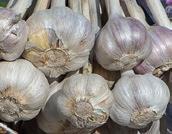
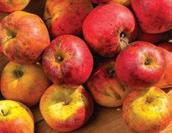


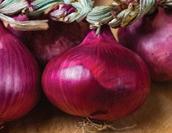







Cuç di mont
Pan di Sorc
Latteria Turnaria Cheese
Moggio Udinese Brovadâr
Onion from Cavasso and Val Cosa
Alto Friuli Heirloom Apples
Carso Marasca Honey
Sauris Fava Bean
San Quirino Bean
Collina Cabbage
Alpine High Mountain Honeys
Resia Garlic or Strok





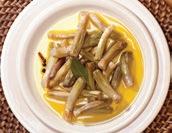

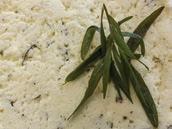
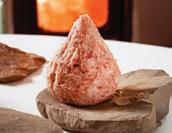
Saurnschotte
Pitina
Alpe Adria Klozen Pears
Pestìth
Carsolina Sheep
Rosa di Gorizia
Radic di Mont
Fagagna Pestàt Varhackara

PHOTO CREDITS
Alessandro Castiglioni
Alessandro Michelazzi
Andrea Maia
Anja Cop
Davide Monti
Fabrice Gallina
Fabio Pappalettera
Francesco Marongiu
Gianluca Baronchelli
Laura Tessaro
Luca Laureati
Marco Milani
Mario Verin
Massimo Crivellari
Ulderica Da Pozzo
Consorzio del Prosciutto di S. Daniele
Slow Food Italia
PROMOTURISMOFVG
Villa Chiozza - Via Carso, 3 33052 Cervignano del Friuli (UD) Tel +39 0431 387111 Fax +39 0431 387199 info@promoturismo.fvg.it www.turismofvg.it
PromoTurismoFVG declines any responsibility for the accuracy and truthfulness of the information provided by the operators, as well as for any errors, omissions, inaccuracies or inaccurate statements resulting from a lack of verification of the information or as a result of the printing process. PromoTurismoFVG undertakes to make every reasonable effort to ensure that the content of the information material and services is accurate and up to date.
HOW TO TRAVEL TO FRIULI VENEZIA GIULIA
BY CAR
Autostrade:
A4 Torino/Trieste
A23 Palmanova/Udine/Tarvisio
A28 Portogruaro/Conegliano
A27/A4 Trieste/Belluno
BY AIR
Trieste Airport triesteairport.it
40 km da Trieste e Udine
80 km da Pordenone
130 km da Venezia
120 km da Lubiana
BY TRAIN
www.trenitalia.it www.italotreno.it
BY BICYCLE
www.alpe-adria-radweg.com www.adriabike.eu

Scan the QR CODE and begin your journey
